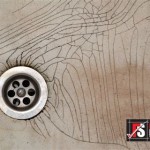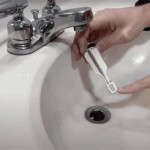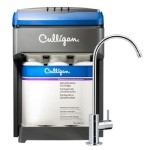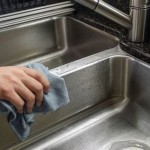Powder Room Vanities With Vessel Sinks: A Comprehensive Guide
The powder room, often the smallest bathroom in a home, presents unique design challenges and opportunities. Space is typically at a premium, requiring thoughtful selection of fixtures and finishes to maximize both functionality and aesthetic appeal. Powder room vanities with vessel sinks have emerged as a popular choice, offering a blend of style, space-saving potential, and design flexibility. This article explores the various aspects of choosing and implementing a powder room vanity with a vessel sink, covering design considerations, material choices, installation factors, and maintenance tips.
Understanding Vessel Sinks and Their Appeal
Vessel sinks, unlike traditional drop-in or undermount sinks, sit directly on top of the vanity countertop. This characteristic visual difference is a major factor in their appeal, allowing them to function as a design focal point. The exposed nature of the sink bowl allows for a greater range of materials, shapes, and finishes, providing more customization options than other sink types. In a powder room, where the sink is often the primary fixture, this level of design flexibility is particularly valuable.
Furthermore, the perceived height advantage of a vessel sink can be leveraged in compact spaces. By choosing a shorter vanity base, homeowners can maintain a comfortable sink height while maximizing under-sink storage or simply creating a sense of openness. The visual separation of the sink from the countertop also contributes to a cleaner, more minimalist aesthetic, which is often desirable in smaller bathrooms.
However, vessel sinks are not without their drawbacks. The raised rim can make them less accessible for some users, particularly children or individuals with mobility limitations. Additionally, the area around the base of the sink can be more prone to water splashes and requires more frequent cleaning to prevent water stains and mildew growth. Proper faucet selection is also crucial to ensure adequate reach and prevent awkward ergonomics.
Key Considerations for Vanity Selection
Choosing the right vanity is paramount when incorporating a vessel sink into a powder room design. Beyond aesthetic preferences, several practical factors should influence the selection process. These include size and layout constraints, storage requirements, material durability, and plumbing considerations.
The dimensions of the powder room will dictate the maximum size of the vanity. In tight spaces, a narrow, wall-mounted vanity may be the most practical option. Wall-mounted vanities create the illusion of more floor space and can be particularly helpful in making a small powder room feel less cramped. Conversely, in larger powder rooms, a wider vanity with ample countertop space may be preferred.
Storage needs are another important consideration. While powder rooms typically require less storage than full bathrooms, providing a designated space for hand towels, soap, and other essentials is still desirable. Vanities with drawers or open shelving can be incorporated to address these needs. If storage is not a major concern, a simple open-shelf vanity can contribute to a minimalist aesthetic.
Material durability is especially important, given the frequent use of powder rooms. The vanity countertop should be resistant to water stains, scratches, and other forms of damage. Popular countertop materials include quartz, granite, marble, and solid-surface materials. The vanity cabinet itself should also be constructed from moisture-resistant materials such as solid wood, plywood with a water-resistant finish, or MDF (medium-density fiberboard) with a melamine coating.
Plumbing considerations include the location of existing water supply lines and drainpipes. Relocating plumbing can be costly and time-consuming, so it’s generally advisable to choose a vanity that can be easily adapted to the existing plumbing layout. The height of the drainpipe also needs to be considered in relation to the vessel sink's drain opening to ensure proper drainage and prevent clogs.
Material Choices for Vanities and Vessel Sinks
The selection of materials for both the vanity and the vessel sink significantly impacts the overall aesthetic and functionality of the powder room. A wide range of materials are available, each with its own unique characteristics, advantages, and disadvantages.
For vanity countertops, quartz has become a popular choice due to its durability, stain resistance, and wide range of color and pattern options. Granite offers a similar level of durability and adds a touch of natural elegance. Marble, while aesthetically pleasing, is more porous and requires more maintenance to prevent staining. Solid-surface materials, such as Corian, are non-porous and easy to clean, but they may not offer the same level of visual appeal as natural stone.
The vanity cabinet itself can be constructed from a variety of materials. Solid wood is a classic choice that offers durability and a warm, natural look. However, solid wood is susceptible to moisture damage and requires proper sealing. Plywood with a water-resistant finish is a more affordable and durable alternative. MDF with a melamine coating is another cost-effective option that is resistant to moisture and scratches.
Vessel sinks are available in a diverse range of materials, including ceramic, glass, stone, metal, and even concrete. Ceramic sinks are the most common and affordable option, offering a wide range of shapes and finishes. Glass sinks add a touch of modern elegance and can be transparent, translucent, or opaque. Stone sinks, such as marble or granite, offer a luxurious and natural look. Metal sinks, such as copper or stainless steel, are durable and resistant to stains.
Concrete sinks are a more contemporary option that adds an industrial-chic touch. The choice of vessel sink material should be based on the desired aesthetic, budget, and maintenance requirements. Lighter materials may be preferable for wall-mounted vanities when load is a concern.
Faucet Selection and Placement
Choosing the right faucet is essential for both the functionality and aesthetics of a powder room vanity with a vessel sink. Because vessel sinks sit above the countertop, standard faucet types may not be suitable. Taller faucets or wall-mounted faucets are often required to ensure adequate reach and prevent water from splashing outside the sink.
When selecting a faucet, consider the height and spout reach. The spout should extend far enough over the sink to allow comfortable hand washing without requiring users to lean too far forward. The height of the faucet should also be sufficient to clear the rim of the vessel sink. If the faucet is too short, it will be difficult to use and may result in water splashing onto the countertop.
Wall-mounted faucets offer a sleek and modern look and can be a good option for small powder rooms where countertop space is limited. They also eliminate the need for faucet holes in the countertop, creating a cleaner and more minimalist aesthetic. However, wall-mounted faucets require more complex plumbing and may be more expensive to install.
The finish of the faucet should complement the other fixtures and finishes in the powder room. Popular faucet finishes include chrome, brushed nickel, oil-rubbed bronze, and matte black. Chrome is a classic and versatile choice that works well with most design styles. Brushed nickel offers a softer and warmer look. Oil-rubbed bronze adds a touch of rustic elegance. Matte black is a contemporary choice that creates a bold and dramatic statement.
Beyond aesthetics, faucet functionality is also important. Choosing a faucet with a single lever control can be more convenient and user-friendly than a faucet with separate hot and cold water handles. A faucet with a built-in aerator can help conserve water without sacrificing water pressure.
Installation and Maintenance Considerations
Proper installation is crucial to ensure the longevity and functionality of a powder room vanity with a vessel sink. While some homeowners may be comfortable with DIY installation, it’s generally advisable to hire a qualified plumber or contractor, especially if plumbing modifications are required.
The first step in the installation process is to prepare the vanity cabinet. This may involve assembling the cabinet, leveling it, and securing it to the wall. Before installing the countertop, it’s important to ensure that it is properly sealed to prevent water damage.
Next, the vessel sink is placed on top of the countertop and secured with a sealant or adhesive. The drain assembly is then installed, ensuring that it is properly connected to the drainpipe. The faucet is installed either on the countertop or on the wall, depending on the type of faucet. Finally, the water supply lines are connected to the faucet.
Once the installation is complete, it’s important to test the sink and faucet for leaks. Check all connections thoroughly to ensure that there are no drips or leaks. Also, test the drain to ensure that it is draining properly.
Regular maintenance is essential to keep a powder room vanity with a vessel sink looking its best. Clean the sink and countertop regularly with a mild soap and water solution. Avoid using abrasive cleaners, which can scratch or damage the finish. Wipe up any spills or splashes immediately to prevent water stains and mildew growth.
Periodically inspect the drain for clogs. If the drain is slow, use a drain cleaner or a plunger to clear the clog. Also, check the faucet for leaks or drips. If the faucet is leaking, repair or replace it as needed.
The area around the base of the vessel sink, where it meets the countertop, is particularly prone to water accumulation. Regularly clean and dry this area to prevent water stains and mildew growth. Consider applying a sealant to this area to create a waterproof barrier.

Exclusive Bathroom Vessel Sinks The Sink Boutique Best S

Gray Marble Vessel Sink In Powder Room Transitional Bathroom

Modern Floating Bathroom Vanity With Vessel Sink Storage Homary

The Pros And Cons Of Vessel Sinks Native Trails

Open Sink Vanity With Vessel Sinks Cottage Bathroom

Vc Cucine 30 In W X 18 5 D 31 H Modern Bathroom Vanity White With Ceramic Single Top Vessel Sink Us02bpvc Mz J 401

Vessel Bathroom Vanities At Com

Bathroom Vanity Shelves

Reclaimed Wood Sink Vanity With Vessel Cottage Bathroom

24 Bathroom Vanity With Vessel Sink







